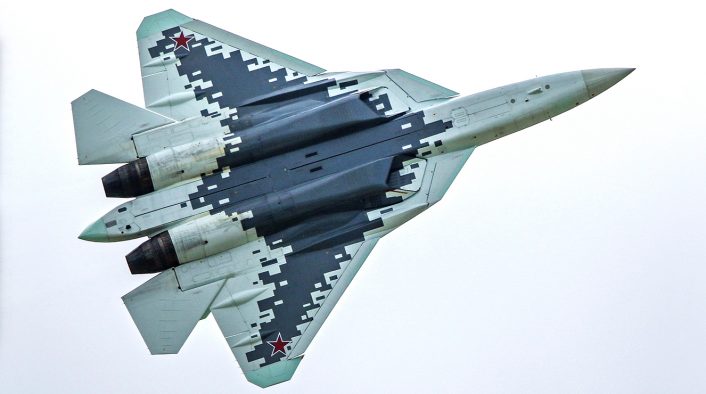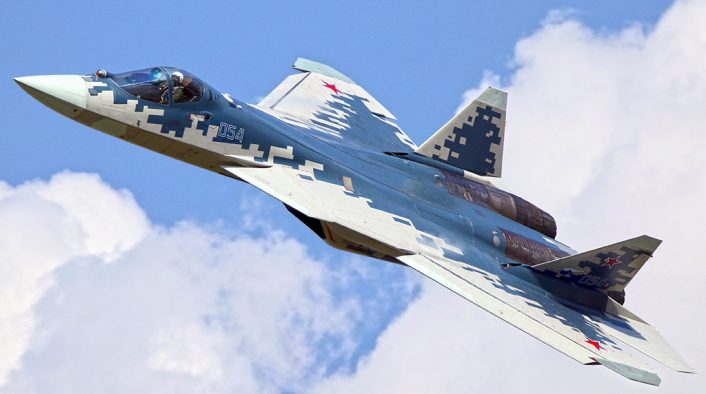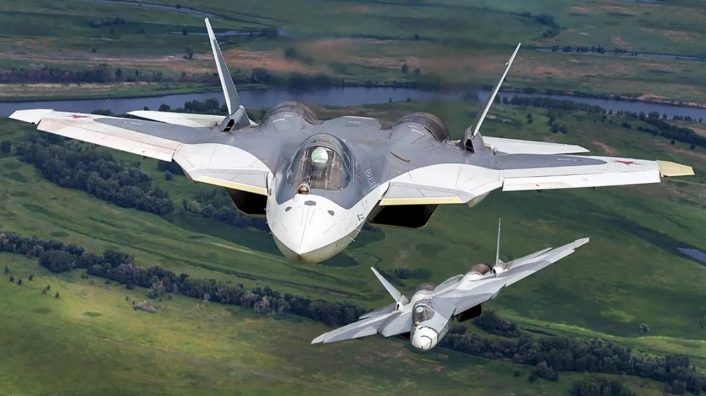The Russian Su-57 (NATO reporting name: Felon), previously known as T-50, is taking part to its first airshow abroad, with two aircraft now arrived at Zhuhai airport for the China International Aviation & Aerospace Exhibition, also simply known as the Zhuhai Airshow. In fact, on Nov. 3, 2024, the Felon’s fourth prototype, T-50-4 “054 Blue”, landed in Zhuhai after a fuel stop at Taiyuan Wusu International Airport.
The second aircraft was brought disassembled and wrapped aboard an An-124 cargo aircraft, apparently to be used only as a static display. Upon unloading, this aircraft has been identified as the seventh prototype, T-50-7 “057 Blue.”
Interestingly, at least one T-50-4 was left available for the public to explore, with many journalists and aviation enthusiasts seen freely roaming around the jet and taking an up-close look. Many photos and videos are already surfacing online, showing various details of the aircraft.
哇!居然可以和苏-57如此接近,这工艺水平你们觉得怎么样? pic.twitter.com/qtUgnDtwWa
— DS北风(风哥) (@WenJian0922) November 4, 2024
The Su-57 has been defined as Russia’s 5th gen fighter jet, in the same class of the U.S. F-22 Raptor and the Chinese J-20 Mighty Dragon. Many, however, dispute this claim because of the airframe’s shape not optimized for low observability and the poor manufacturing of its surfaces, with gaps, screws and rivets clearly visible and not flush with the surface.
The latter problem appears to be limited only to the prototypes and addressed on the production aircraft, with a more clean finish. Regarding the former, the Russians say the goal was to have a radar cross section optimized for a frontal low observability.
That’s…. really poor quality control there. Not good for low observability on top of already poorly optimised shaping! 😬#Su57 #Felon https://t.co/GZTAqySiDJ
— Justin Bronk (@Justin_Br0nk) November 4, 2024
In fact, it appears that the Felon, unlike the J-20 or the F-22 and F-35, was never designed to be an air superiority jet with pure radar evading and LO (Low Observability) features, but rather a long-range, heavy payload, super maneuverable platform capable of standoff anti-air and anti-surface attacks.
The aircraft in Zhuhai
The jet’s initial units left a lot to be desired for, with poor workmanship which reflected on 054’s airframe panels as seen when it arrived at Zhuhai airport on Nov. 3. As mentioned, “054 Blue” was one of the first prototypes, and first flew on Dec. 12, 2012, from Kosomolsk-on-Amur, when the project was still designated with the original development title, the T-50 PAK-FA.
The other aircraft presents similar defects. As mentioned earlier, “057 Blue” was transported in a disassembled form on an Antonov An-124, without the radome, wings and the vertical stabilizers. This would be the aircraft used for static display, while 054 would perform the aerial displays, consistent with the SDB (Sukhoi Design Bureau) usually using this airframe for the purpose. The Felon is likely to be piloted by Sergey Bogdan, SDB and UAC’s (United Aircraft Corporation) senior test pilot.
Let’s now go over the photos and videos surfacing online, which are causing lots of criticism in China about the poor manufacturing and quality control. In fact, a close-up walkaround video of the plane shared on X by a few handles, sourcing it from a Weibo account, revealed crude workmanship on the aircraft’s panels and the airframe in general.
珠海航展へやってきたSu-57は飛来した054機は柵もなく現地民が超至近距離で自由に撮影出来る状態で、An-124に搭載され輸送されてきた静的展示用の057機も同じくAn-124機内からその搬出まで撮影出入り自由。
どうせ正式開催日前の現地には中国人しか居ないしJ-20やJ-35が参加する珠海で厳しくしてもね。 https://t.co/AEpPWZ21H2 pic.twitter.com/nsL76mqiEA— お砂糖wsnbn (@sugar_wsnbn) November 4, 2024
Some examples are the hexagonal panel below the cockpit and another one beside it; the movable leading edge root extension; and the wing’s weapons bay. The hexagonal panel covers the side-looking (or ‘cheek’ mounted) X-band AESA (Active Electronically Scanned Array) radar installed under the cockpit, which is is meant to complement the X-band N036 Byelka AESA radar in the nose radome.
The missile bay’s section also shows poor panel fitment, with gaps and various defects on the panel’s edges. The screws holding these panels are visible and appear to be at different depths, suggesting they were fitted tightly just enough to hold the panels together, as well as featuring multiple head types.
Chinese social media are reportedly comparing the Su-57 to the J-20, mentioning that the former doesn’t meet the expectations of what has been defined as state-of-the-art aircraft. The crude and rudimentary finishing are a testament to the Russian Federation’s economic troubles for the first two decades after the collapse of the Soviet Union, which had a bearing on its defense projects, until things started to turn around in 2013.
Sukhoi Su-57 Felon in Taiyuan Wusu International Airport pic.twitter.com/gGXDVG67Kv
— MartinYu🇺🇦 (@MartinY94321052) November 3, 2024
There are varying reports on the materials that make up the Su-57. Discussions on Russian Telegram channels claim it has a mix of strong carbon-fiber composites and metal, to balance the low weight and strong airframe requirements during high-speed and tight maneuvering flight profiles. There is however little information in this regard, with this aspect remaining uncertain.
The walkaround video of “054 Blue” also shows that, except for the IRST (Infra-Red Search and Track) ahead of the windshield, the N101KS electro-optical suite appears to be missing. This suite’s sensors are located on the ventral underside just behind the chin section, and on the dorsal spine behind the cockpit. They are however seen on the subsequent prototypes and other serial production models.
The Su-57 Felon
The Sukhoi Su-57, developed since 2002, is intended to be the first stealth aircraft in Russian military service. The aircraft made its first flight on Jan. 29, 2010, with first serial production Felon delivered at the end of 2020.
The requirements envisioned an aircraft capable of supersonic cruise flight with a long combat radius, low radar cross section, super-maneuverability and STOL (Short Take Off and Landing) characteristics, while retaining a substantial ground attack capability. The Su-57 features a substantially reduced Radar Cross Section compared to 4th generation Russian jets, principally in the frontal sector. It seems to be a compromise between reducing the RCS and obtaining high maneuverability and performance while maintaining large weapons bays to accommodate heavy payloads.
The Su-57’s design includes a blended wing body fuselage, all-moving horizontal and vertical stabilizers, with the vertical stabilizers doubling as airbrakes. It features thrust vectoring and adjustable leading-edge vortex controllers (LEVCONs) that manage vortices from the leading-edge root extensions, improve high angle of attack behavior, and allow quick stall recovery if needed.
Its advanced flight control system and thrust vectoring nozzles make it highly maneuverable in both pitch and yaw, enabling maneuvers such as Pugachev’s Cobra and the bell maneuver, and performing flat rotations with minimal altitude loss.
The aircraft is said to extensively use composite materials, comprising 25% of its structural weight and nearly 70% of its outer surface, as well as Radar Absorbing Materials (RAM). Some of these composite materials had to be sourced from abroad, but now they have been reportedly replaced by “Made in Russia” materials.

Weapons are stored in two tandem main bays between the engine nacelles and smaller side bays near the wing root, reducing drag and enhancing performance and stealth compared to external carriage. A technology that was showcased on the production line is the use of Augmented Reality during a number of processes in the assembly of the Su-57, with some examples showing its usage on the fuselage and the landing gear.
The main avionics systems are the Sh121 Multifunctional Integrated Radio Electronic System (MIRES) and the 101KS Atoll Electro-Optical System.
The Sh121 MIRES consists of the N036 Byelka radar and the L402 Himalayas electronic countermeasure systems. The N036 Byelka radar features five AESA (Active Electronically Scanned Arrays) systems, three X-band and two L-band, and it’s also the first AESA radar used on a Russian aircraft. The X-band arrays are the main ones, mounted frontally in the nose and laterally in the cheeks of the forward fuselage, just below the cockpit, for a total estimated radar coverage of 270 degrees.
The side-looking radar could enable the Su-57 to employ extreme beaming tactics, where the fighter turns 90 degrees away from an enemy’s pulse doppler radar exploiting the blind spot of this technology (the radar filters out low relative velocity objects and the beaming fighter, which appears stationary to the radar, disappears from the enemy radar screen) while still guiding its weapons on target. The two L-band antennas are mounted in the wing’s leading-edge extensions and used for the IFF (Identification Friend or Foe) and for Electronic Warfare. The L402 Himalayas is mounted in the tail between the engines and uses both its own arrays and the N036 arrays.
The 101KS Atoll Electro-Optical System consists of five subsystems. The first one is the 101KS-V, an Infra-Red Search and Track (IRST) turret mounted in front of the cockpit to detect, identify, and track airborne targets. The 101KS-O Directional Infra-Red Counter Measures (DIRCM) turrets, mounted on the dorsal spine and under the fuselage, is a novelty for a tactical jet. The system is usually found on helicopters and uses modulated laser-bases beams to confuse heat-seeking (or infra-red homing) missiles.

The 101KS-U is an ultraviolet Missile Approach Warning Sensor (MAWS) against infra-red homing missiles and works in conjunction with the DIRCM turrets. At least four sensors are installed in various points on the fuselage. The 101KS-P is a high-resolution thermal imager used for low-altitude and night operations. Two sensors are mounted in front of the compartments for the short-range missiles under the wing roots. The last system is the 101KS-N navigation and targeting pod, mounted externally under the air intakes and with functions similar to modern U.S./NATO targeting pods like Litening and Sniper.
The Su-57’s aerodynamics and engines enable it to achieve Mach 2 and supercruise without afterburners, providing a significant performance advantage over previous generations. With a high fuel load, its supersonic range exceeds 1,500 km (930 mi), more than twice that of the Su-27, and an extendable refueling probe can further increase its range. According to a U.S. military assessment, in its design, Sukhoi addressed perceived limitations of the F-22, such as limited thrust vectoring for roll and yaw and insufficient space for weapons bays between the engines, and improved stall recovery procedures.
Initial prototypes and early production models used an upgraded variant of the Lyulka AL-31 engine, the AL-41F1A. A new engine was specifically developed for the Su-57, known as Izdeliye 30 (literally Product 30). The Product 30, which should provide 18,000 kgf of thrust instead of the 15,000 kgf of the AL-41F1A, is supposed to be more efficient than previous designs and able to give the Felon a top speed in excess of Mach 2 and a supercruise capability at Mach 1.3, featuring also 3D thrust vectoring and a “stealthier” nozzle. Production of the Product 30 engine began in 2022; the first serial deliveries of the Product 30-equipped Su-57 started in 2023.
The Sukhoi Su-57 was often criticized by experts for many features that could degrade the low observability such as rivets, weapon doors’, engine nacelles’ and air inlets’ rounded shaping, rough panel’s seamlines, etc. Some of those problems seem to be mitigated in later prototypes and more could have been solved before the serial production. Many of these seem to be missing, or at least reduced, on the aircraft that are now being built serially.

Su-57 has been upgraded
The Su-57 was claimed to have AI-enabled pilot “support” and assistance technology, when the first “upgraded” version of the jet undertook its maiden flight on Oct. 21, 2022 from the Gromov Flight Testing Institute. In Dec. 2023, reports quoted UAC officials saying the new AL-51F-1 turbofan (or Izdeliye 30) was ready, and that all Su-57 airframes transferred to the RuAF (Russian Aerospace Forces) in 2024 will have this power plant. Until then, the Su-57 flew with the NPO Saturn Product 117 engine, derived from the Su-35’s afterburning AL-41F-1S engines.
The UAC reports that the final new batch of Su-57s have been transferred to the Russian Defense Ministry for 2023. pic.twitter.com/SH1jpLltbt
— ayden (@squatsons) December 27, 2023
The AL-51F-1 features serrated exhaust nozzles that contribute in reducing the jet’s exhaust heat and IR signature. Open source information gathered by former IAF (Indian Air Force) Jaguar pilot, Squadron Leader Vijainder K. Thakur showed Russia RuAF receiving one, three, six and 12 airframes from the UAC in 2020, 2021, 2022 and 2023, respectively. The jets that were delivered also did not appear to sport the serrated exhaust nozzles. That report from Sep. 2024 also said only two or three rolled out of the UAC factory, meaning it had fallen behind its production targets for this year.
It can be said that the Su-57 has fallen behind production targets owing to high-end aerospace component manufacturing and precision parts production issues Russia is facing since the sanctions after Feb. 2022. However, it could also be argued that Moscow is in no hurry as it is not extensively reliant on the Su-57 for operations in Ukraine, with ground attacks and battlefield interdiction strikes undertaken by the Su-34 Fullback.
‼️ Another batch of newly built Su-57s & Su-35Ss joins 🇷🇺RuAF
No video of Su-35Ss 😏
🎥 United Aircraft Company pic.twitter.com/RLbgb9YQzq— KURYER🤔 (@RSS_40) September 12, 2024
Russia’s present focus is on refining the platform and incorporating technologies from the lessons learnt in Ukraine, so it does not mind if it has less Su-57s operational against Kyiv. This fighter is largely meant for NATO air forces’ advanced Western jets like the F-35 Lightning II, newer version of the Eurofighter Typhoon, Dassault Rafale and the F-15EX, when they enter service.

